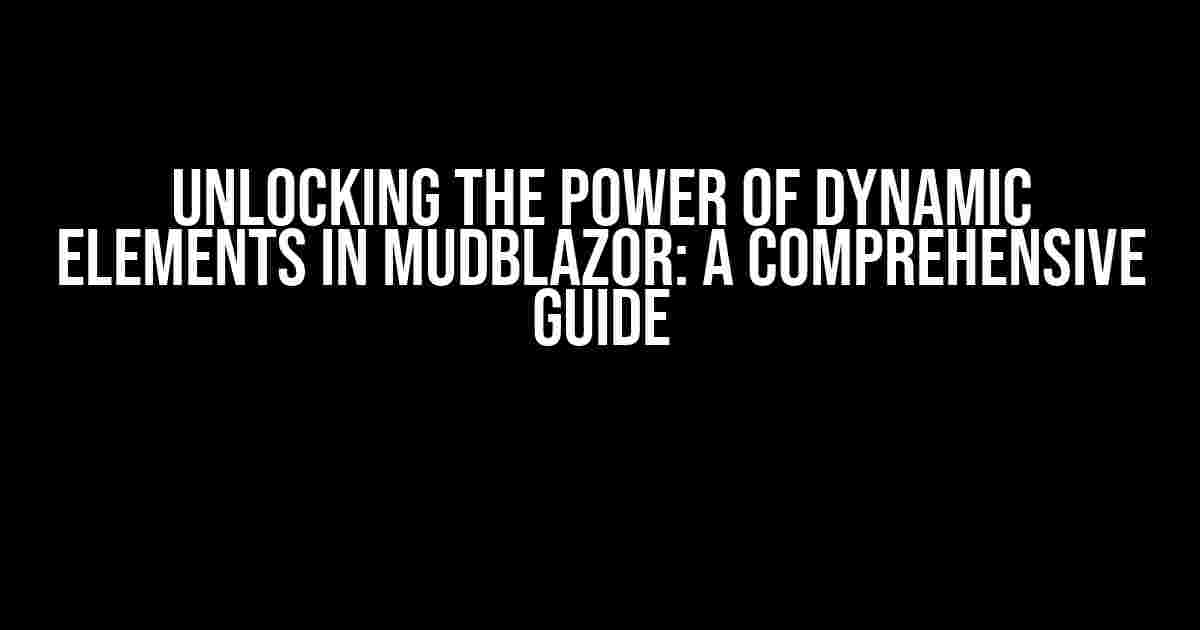Are you tired of static and unengaging web applications? Do you want to take your user experience to the next level? Look no further! MudBlazor’s dynamic elements are here to revolutionize the way you build and interact with web applications. In this article, we’ll explore the world of dynamic elements in MudBlazor, covering the what, why, and how of this powerful feature.
What are Dynamic Elements in MudBlazor?
In MudBlazor, dynamic elements refer to components that can be added, removed, or modified at runtime, allowing for a more interactive and responsive user experience. These elements can be used to create complex and dynamic layouts, responsive designs, and even entire applications that adapt to user input.
Types of Dynamic Elements in MudBlazor
MudBlazor offers a range of dynamic elements, each with its own unique capabilities and use cases. Some of the most popular dynamic elements include:
MudCollapse: A dynamic component that can be collapsed or expanded to show or hide content.MudDrawer: A sidebar component that can be toggled on or off to provide additional functionality or navigation.MudExpand: A dynamic component that can be expanded or contracted to show more or less content.MudNavMenu: A dynamic navigation menu that can be configured to display different items based on user input or application state.
Why Use Dynamic Elements in MudBlazor?
So, why should you use dynamic elements in MudBlazor? Here are just a few compelling reasons:
- Improved User Experience: Dynamic elements allow you to create a more interactive and engaging user experience, making your application more enjoyable to use.
- Increased Flexibility: Dynamic elements give you the flexibility to create complex and adaptive layouts that can be easily modified or updated.
- Enhanced Responsiveness: Dynamic elements enable you to create responsive designs that adapt to different screen sizes, devices, and orientations.
- Better Performance: By only rendering the necessary elements, dynamic elements can improve the performance of your application.
How to Use Dynamic Elements in MudBlazor
Now that we’ve covered the what and why of dynamic elements in MudBlazor, let’s dive into the how. Here are some step-by-step instructions on how to use dynamic elements in your MudBlazor application:
Step 1: Install MudBlazor
To get started, you’ll need to install MudBlazor in your .NET Core project. You can do this by running the following command in your terminal:
dotnet new mudblazorappStep 2: Add a Dynamic Element to Your Application
Once you’ve installed MudBlazor, you can start adding dynamic elements to your application. For example, let’s add a MudCollapse component to our application:
<MudCollapse @bind-Open="@isOpen">
<h2>This is a collapsible section</h2>
<p>This content will be hidden when the collapse is closed</p>
</MudCollapse>Step 3: Configure the Dynamic Element
Next, you’ll need to configure the dynamic element to respond to user input or application state. For example, you can add a button to toggle the MudCollapse component:
<MudButton @onclick="() => isOpen = !isOpen">Toggle Collapse</MudButton>Step 4: Style the Dynamic Element
Finally, you can style the dynamic element using CSS or MudBlazor’s built-in styling options. For example, you can add a CSS class to the MudCollapse component:
<MudCollapse @bind-Open="@isOpen" Class="my-collapse">
<h2>This is a collapsible section</h2>
<p>This content will be hidden when the collapse is closed</p>
</MudCollapse>Best Practices for Using Dynamic Elements in MudBlazor
When using dynamic elements in MudBlazor, there are a few best practices to keep in mind:
| Best Practice | Description |
|---|---|
| Keep it Simple | Avoid overusing dynamic elements, as this can lead to complex and confusing layouts. |
| Test Thoroughly | Test your dynamic elements thoroughly to ensure they work as expected in different scenarios. |
| Use Meaningful Names | Use meaningful names for your dynamic elements and variables to make your code easier to read and maintain. |
| Optimize for Performance | Optimize your dynamic elements for performance by minimizing the number of DOM mutations and using caching where possible. |
Conclusion
In this article, we’ve explored the world of dynamic elements in MudBlazor, covering the what, why, and how of this powerful feature. By following the steps and best practices outlined in this article, you’ll be well on your way to creating engaging, interactive, and responsive web applications that adapt to user input and application state. So, what are you waiting for? Get started with dynamic elements in MudBlazor today!
Here are the 5 Questions and Answers about “Dynamic elements in MudBlazor” in HTML format:
Frequently Asked Questions
Get the inside scoop on MudBlazor’s dynamic elements!
What are dynamic elements in MudBlazor?
Dynamic elements in MudBlazor are components that can be added, removed, or modified at runtime, allowing for a more interactive and dynamic user interface. They can be used to create responsive and adaptive UI components, such as accordions, tabs, and dropdowns, that can be controlled programmatically.
How do I create a dynamic element in MudBlazor?
To create a dynamic element in MudBlazor, you can use the `MudDynamicElement` component and pass a `RenderFragment` as a parameter. This allows you to define the content of the element at runtime. You can also use the `StateHasChanged` method to update the element’s state and trigger a re-render.
Can I use dynamic elements with other MudBlazor components?
Yes, you can use dynamic elements with other MudBlazor components. Dynamic elements can be used as children of other components, such as `MudCard`, `MudGrid`, or `MudTable`, to create complex and dynamic UI layouts. You can also use dynamic elements to create custom components that can be reused throughout your application.
How do I handle events on dynamic elements in MudBlazor?
To handle events on dynamic elements in MudBlazor, you can use the `@on_EVENT` syntax, where `EVENT` is the name of the event you want to handle. For example, `@on_Click` to handle a click event. You can also use the `StateHasChanged` method to update the element’s state and trigger a re-render after an event has been handled.
Are dynamic elements in MudBlazor SEO-friendly?
Yes, dynamic elements in MudBlazor are SEO-friendly. MudBlazor uses server-side rendering (SSR) to generate static HTML content that can be crawled by search engines. This means that even though dynamic elements are generated at runtime, they are still accessible to search engines and can improve your application’s SEO ranking.






